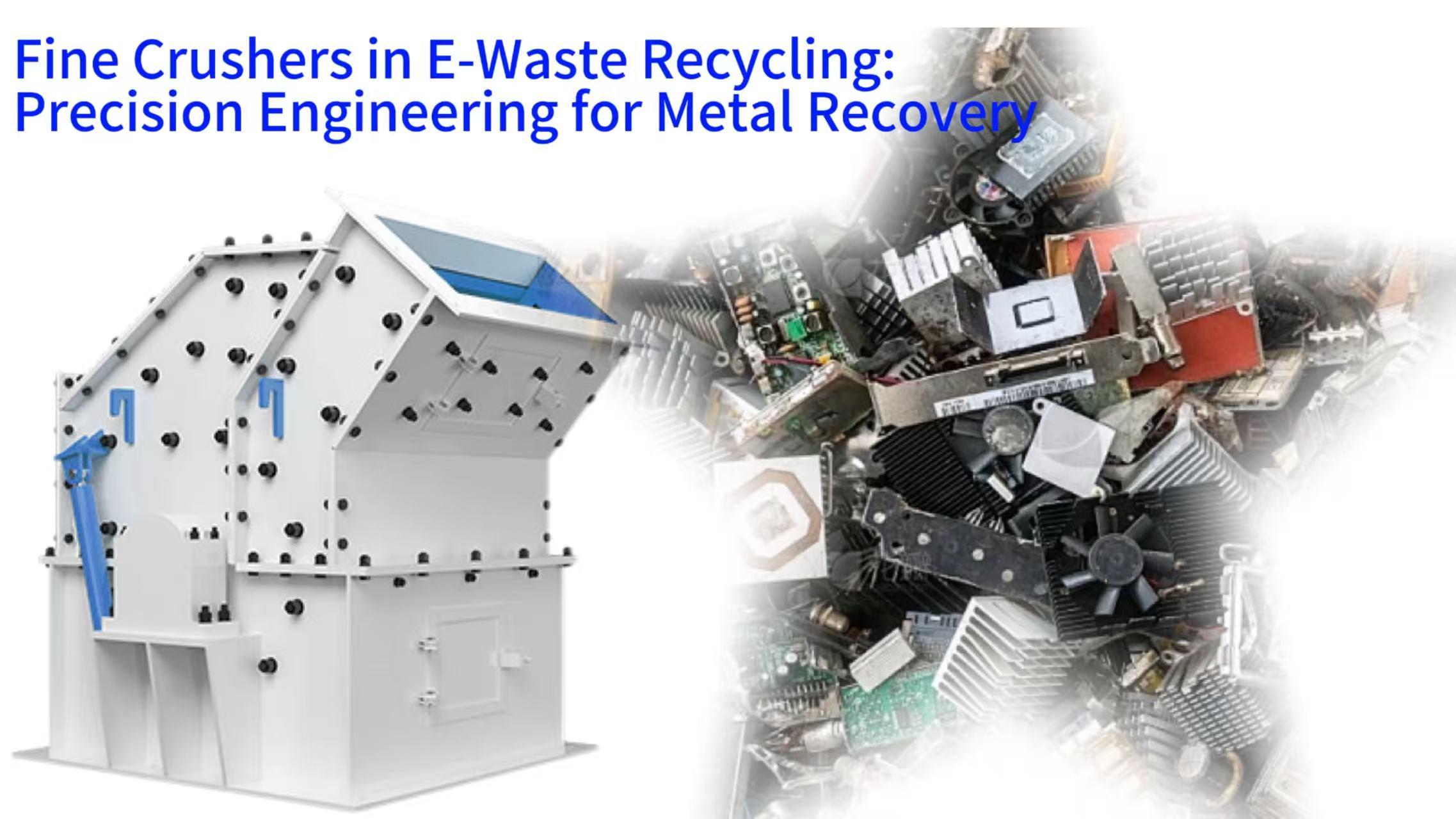Fine Crushers in E-Waste Recycling: Precision Engineering for Metal Recovery

The processing of electronic waste (e-waste) demands specialized machinery to liberate valuable metals from complex composite materials. Fine crushers play a pivotal role in breaking down circuit boards, metal casings, and batteries into optimized particle sizes, enabling efficient separation of gold, silver, copper, and rare earth elements. This article explores the technical alignment of fine crushers with e-waste recycling workflows, emphasizing particle size control, material-specific adaptations, and process integration strategies.
The Unique Challenges of E-Waste Crushing
Electronic废弃物 presents a paradoxical blend of brittle and ductile materials. Glass components from screens and capacitors require gentle fragmentation to avoid dust generation, while metallic elements like copper traces and gold-plated connectors demand sufficient energy for complete liberation. The coexistence of lead-soldered joints and mercury-containing switches introduces environmental risks if improper crushing spreads toxic particles.
Research indicates that PCX-type fine crushers excel in handling this duality. Their adjustable impact velocities allow selective fragmentation: lower speeds preserve glass integrity while higher speeds shatter metallic bonds. This dual-mode operation prevents cross-contamination between hazardous substances and recoverable metals, aligning with WEEE directive requirements for particle size distribution.
Functional Positioning in the Recovery Chain
Fine crushers act as the critical transition between primary shredding and downstream separation. While jaw crushers handle coarse reduction, fine crushers refine particles to<2mm sizes optimal for eddy current separation and froth flotation. The VSI crusher's vertical shaft design proves particularly effective here, generating cubic particles that enhance metal-plastic interface exposure during subsequent washing stages.
Case studies from mobile phone recycling demonstrate that closed-circuit systems - combining crushers with adjustable ring classifiers - reduce metal loss by 18% compared to open circuits. This configuration maintains a narrow particle size band, critical for magnetic separation efficiency where iron particles >5mm escape detection but<2mm particles require precise density differentiation.
Material-Specific Crushing Dynamics
Circuit boards require a balance between liberation and dust control. Impact crushers with tungsten carbide blow bars achieve 95% copper liberation at 0.6mm particle size without excessive fiberboard pulverization. In contrast, lithium-ion battery modules demand inert atmosphere crushing to prevent thermal runaway, necessitating nitrogen-purged chambers in hammer mill designs.
Statistical modeling reveals that aluminum casings from laptops achieve optimal separation efficiency at 1.2mm particle sizes, while gold finger connectors require sub-0.5mm fragmentation for complete dissolution in cyanide leaching. This granularity precision explains the growing adoption of European grinding mills in precious metal recovery lines.
Process Integration and Automation
Modern fine crushers integrate with real-time particle analysis systems. Laser diffraction sensors mounted on discharge chutes feed data to variable frequency drives, dynamically adjusting rotor speeds to maintain target particle sizes. This closed-loop control reduces over-crushing of valuable metals by 30% compared to manual operation, directly improving downstream smelting yields.
The synergy between crushers and separation equipment is exemplified in printer cartridge recycling. After PE-series jaw crushers reduce cartridges to 50mm chunks, fine crushers operating at 1,200rpm liberate toner powder from plastic casings while preserving steel drum integrity. The resulting 2-4mm particles flow seamlessly into air classification systems without requiring intermediate screening.
Maintenance and Operational Efficiency
Wear component design significantly impacts total cost of ownership. Chromium alloy liners in gyratory crushers last 1,200 hours in e-waste applications versus 800 hours for manganese steel alternatives. However, ceramic-coated rotors in VSI crushers demonstrate superior resistance to glass abrasion, extending service intervals to 1,500 hours despite higher initial costs.
Predictive maintenance algorithms analyze vibration patterns from tracked crushers to forecast bearing failures. This reduces unplanned downtime by 45% in multi-stage crushing lines handling mixed e-waste streams. Remote monitoring systems further enable cross-regional fleet management, optimizing spare parts allocation based on real-time wear data from connected crushers.
Case-Specific Optimization Strategies
Server motherboard recycling requires two-stage crushing: initial PCZ hammer mills reduce boards to 10mm pieces, followed by fine crushers with 0.8mm gap settings to separate gold-plated traces from fiberglass substrates. This sequential approach achieves 98% metal purity versus 82% in single-stage processes.
For cathode ray tube (CRT) recycling, double roll crushers operating at 50rpm gently separate glass funnels from metal cones without generating respirable silica dust. The resulting 50-100mm glass fragments require no further size reduction before lead extraction, reducing total processing energy by 25% compared to alternative methods.
Quantifying System-Wide Benefits
Life cycle assessments (LCAs) of e-waste facilities show that fine crushers contribute 35-40% of total metal recovery value through precise particle sizing. A 0.2mm reduction in average particle size across a plant's crushers can increase copper recovery by 12%, offsetting the energy costs of additional grinding stages. This efficiency gain becomes critical when processing low-grade e-waste streams like solar panels.
Policy frameworks further amplify these benefits. Facilities complying with EU Circular Economy Action Plan particle size mandates report 20% higher material revenues than non-compliant operations. The economic calculus becomes clear: investing in advanced fine crushers with automated control systems yields payback periods under 18 months for medium-scale e-waste processors.